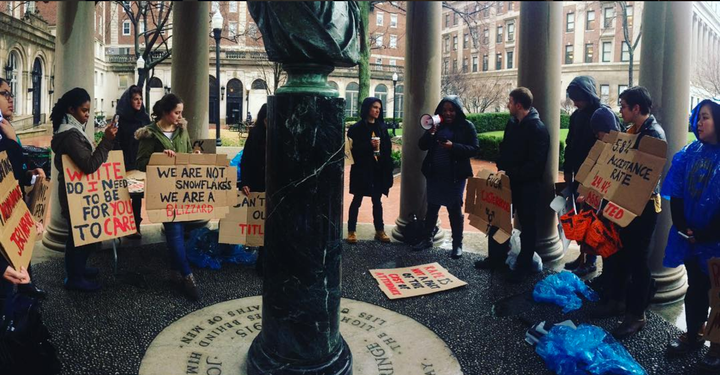Content warning: sexual and domestic violence
On February 9, 2017, an undocumented transgender woman walked into the El Paso County, TX courthouse to get a protective order against her abusive boyfriend. She walked out in handcuffs.
The U.S. Immigration and Customs Enforcement (ICE) officers who arrested the woman apparently received a report that “Ervin Gonzalez” — the woman referred to by her dead name — was in the country illegally.
The woman is still in ICE custody and will likely be deported.
*
On July 28, 2016, a 14-year-old Black girl named Bresha Meadows shot and killed her abusive father.
Her father routinely beat her mother to the point of broken bones. Despite the mountain of protective orders, police reports, and hospital records backing Bresha’s claims of domestic violence, the Warren, OH police department arrested Bresha.
Bresha remains incarcerated and faces trial for aggravated murder.
*
On December 18, 2015, a bipolar rape victim from Harris County, TX had a nervous breakdown while testifying against her rapist. Harris County prosecutors instructed the police to arrest her to ensure she would return to testify.
The woman was incarcerated in the same jail as her rapist for a month, denied psychiatric medication, and subjected to routine physical abuse.
*
The failure of the criminal justice system to address gender-based violence is not a new revelation. Often, it’s discussed in the context of criticizing the United States’ backlog of untested rape kits. National anti-violence organizations, such as the Rape, Abuse & Incest National Network, remind the public only 1 in 16 rapists ever spends a day in jail.
Then on March 31 of this year, 100 organizations sent a letter to the Trump administration demanding Title IX enforcement.

#CantTrumpOurTitleIX Rally
Title IX, the federal law outlawing sex discrimination in education, was used through President Obama’s tenure to address gender-based violence on campuses.
The new Title IX demand letter, which I had the privilege of helping draft, took the Obama administration’s vague Title IX protections a step further to protect marginalized survivors, including demands such as, “Recognize that harassment and coercion take many forms, including targeting individuals based on their immigration status …, threatening to ‘out’ someone as queer or trans, and purposefully using incorrect gender pronouns (or otherwise misgendering someone).”
As Brandee Blocker Anderson, an assault survivor and law student at Columbia University, put it in a message to me, “[The letter] calls for a strengthening of the current protections that the Office for Civil Rights guidelines have already set out, in terms of due process; OCR enforcement; mental health and academic accommodations; and protections for LGBT students, undocumented students, and students of color.”
Perhaps the most controversial demand was the one buried on the third page stating, “Investigations should remain completely independent from law enforcement as to protect Black students and students of color, undocumented students, trans students, and others who are vulnerable to state violence.”
To those who have listened to testimony from assault survivors such as myself about schools failing to address violence, a demand to separate school processes and the criminal justice system may seem strange.
However, many campus anti-violence activists still support Title IX.
“Title IX helps hold perpetrators of gender-based violence accountable without involving the police or incarceration … and highlights how gender-based violence intersects with racism, xenophobia, transphobia and other forms of oppression,” said one student at a March 31 rally in New York City supporting Title IX.
Indeed, the criminal justice system is heavily intertwined with the types of discrimination that enable violence.
Black men are six times more likely than white men to be incarcerated. The criminal justice system routinely targets queer and trans people. And undocumented people are considered criminals by virtue of their immigration status.
In addition, people of color, undocumented people, and queer and trans people are often subjected to violence at the hands of law enforcement. Some recent estimates have found Black people are three times more likely than white people to be killed by the police. And stories like those of the women sexually victimized by police officer Daniel Holzclaw serve as a reminder of the enormous latitude police officers are given on the job.
Against this backdrop, it seems we find ourselves repeatedly asking the question: how can we expect a discriminatory system to treat victims who fall within marginalized identity groups as victims?
Lisa Marie Cacho, an Associate Professor of Latina/Latino Studies and Asian American Studies, explained in her book, Social Death:
“[People of color] cannot access legal protection because they are the people against whom the law must discriminate in order to protect everyone else against discrimination. In other words, legal equality is possible for everyone else because criminalized populations of color are ineligible for rights and personhood.”
In addition to endangering victims, the criminal justice system endangers perpetrators. Incarcerated individuals often become victims of prison sexual violence, are stripped of voting rights, and are denied employment opportunities.
The appeal of Title IX to many students, especially during President Trump’s pro-policing reign, is the burden of proof — preponderance of the evidence — is attainable and the punishment for committing acts of violence centered on safety (no-contact directives, removal from campus grounds, counseling). Title IX also mandates schools provide accommodations for survivors of violence, such as psychological and academic support often inaccessible to low-income survivors.
Proponents of the criminal justice system are quick to point out schools often fall short of the ideals in the Title IX demand letter. Schools fail to promptly investigate complaints of gender-based violence, decline to provide survivors with accommodations, and saddle survivors with hefty medical bills.
Some people, like academic Laura Kipnis, assert Title IX processes are often witch hunts of sorts, despite studies finding only 2-8% of sexual violence allegations are false.
In an April 2017 article in The Chronicle of Higher Education, Kipnis claimed:
“My inbox became a clearinghouse for depressing and infuriating tales of overblown charges, capricious verdicts, and frightening bureaucratic excess. I was introduced to an astonishing netherworld of sexual finger-pointing, rigged investigations, closed-door hearings, and Title IX officers run amok.”
In addition, some people question the validity of prevention education, which focuses on bystander intervention and obtaining consent in line with recommendations from the Centers for Disease Control and Prevention.
Cathy Young argued in a 2014 article in the Boston Globe, “While violent offenders can sometimes be reformed through learning empathy, this process not only requires intensive intervention but has a fairly modest success rate.”
However, the system Title IX aims to create — one focused on violence prevention and healing — has the potential to address the needs of marginalized survivors and promote justice. In contrast, the criminal justice system has an established lineage of failing to prevent recidivism and criminalizing people who, to reuse the words of Cacho, are considered “ineligible for rights and personhood.”
The rapist in Harris County was convicted.
Bresha Meadows’s father will never again harm her mother.
The El Paso County woman was granted her Order of Protection.
But in a criminal justice system that criminalizes marginalized survivors and exposes perpetrators to violence, their cases remind us that victories aren’t always the same thing as justice.
Need help? In the U.S., call 1-800-799-SAFE (7233) for the National Domestic Violence Hotline .
